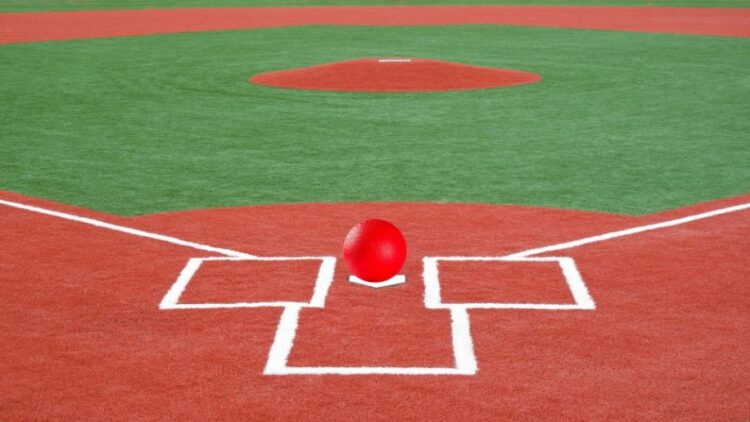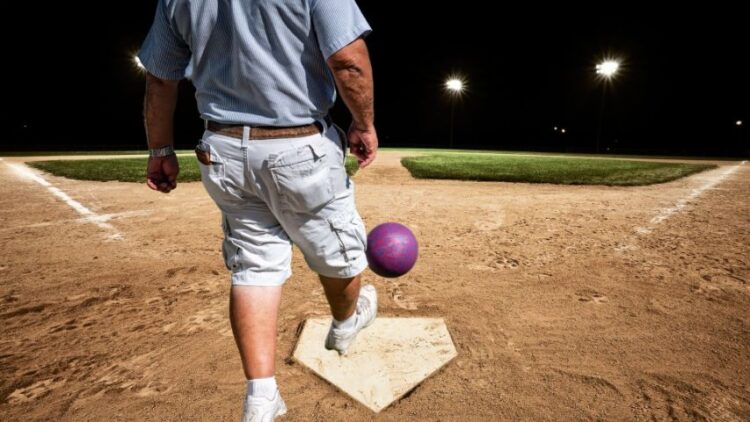
OBJECTIVE OF KICKBALL: Score more runs than the opposing team by kicking a ball and running around the bases.
NUMBER OF PLAYERS: 18 players (9 per team)
MATERIALS: Bases, kickball
TYPE OF GAME: Sport
AUDIENCE: 6+
OVERVIEW OF KICKBALL
Kickball is a team sport that fuses elements of soccer and baseball. This sport is essentially baseball played with a large rubber ball that is kicked instead of hit with a bat. Appropriately, many countries outside the United States (mainly Canada) refer to this sport simply as “soccer baseball”.
Kickball was allegedly invented by American Emmett Dunn Angell in 1910 under the name “kicking baseball”, although its actual inventor is still a somewhat disputed topic. However, as early as 1920, “kickball” was being used in American schools to teach younger kids the basics of baseball in an easy and accessible way. But this early form of kickball wasn’t very reminiscent of baseball, as neither team had a pitcher (the ball was simply kicked from home plate), and certain areas of the outfield weren’t accessible until the ball was in play.
This sport would later gain popularity as an activity played by American soldiers in World War II. However, the sport evolved even further from traditional baseball during this time. Kickball has undergone many rule changes throughout the years, although the most popular form of the sport played today is that which is as similar to baseball as possible. Today the sport rules for competitive play are overviewed by the World Adult Kickball Association
SETUP

EQUIPMENT
- Bases: Kickball is typically played on a baseball or softball field. However, the game can also be played anywhere else as long as you can set up four bases like in a typical baseball diamond.
- Kickball: A rubber ball (often red in color) that measures 10 inches in diameter. These balls are usually interchangeable with traditional rubber dodgeballs, and any other medium-sized ball (such as a soccer ball) should work as an alternative.
- Foul lines: Foul lines extend forward from home base 10 feet. Any kick within these lines is considered fair play.
TEAMS
In kickball, two teams alternate between offense and defense. Each team is ideally the same size as a baseball team (9 players), although you can easily play recreational kickball with more (or fewer) players.
The offensive team lines up behind home plate. The first player in line kicks a ball that is pitched (rolled) to them by the opposing team’s pitcher. After kicking the ball, the player tries to make it to the safety of a base before the next player in line repeats the process. The goal of a player on base is to make it around all the bases and back to home plate to score a run.
The defensive team positions themselves around the field. Ideally, each player will be given a position or area of the field to defend. Just like in baseball, there should be a player covering each base (except for home plate), players in the outfield, and at least one player in between the bases (a shortstop). One player must also hold the responsibility of being a pitcher and rolling the ball to the offense. Unlike in baseball, however, the pitcher in kickball is just trying to get the ball in play; they can’t record a strikeout.
GAME STRUCTURE
Like in baseball, kickball allows each offensive team three “outs” per inning to kick the ball. Once the third out is secured, both teams switch sides (offense switches to defense, and vice versa). After both teams have had a chance on offense, the next inning starts.
Ideally, kickball games are played through seven innings (for reference, baseball is nine). However, since this game is often played as part of gym class in schools, the number of innings is often reduced to five or fewer, depending on time constraints.
GAMEPLAY

SCORING
The objective of kickball is to score runs by running around all of the bases and making it back to home plate (which scores one run). Depending on where the game is being played, a ball kicked outside of the playing area is considered a “home run” and automatically results in all players on base—including the kicker—getting a free run to home plate. For example, if there are two players on base, a home run results in 3 runs being scored by the team.
Therefore, a single homerun could score between one and four runs depending on how many players were on base. With that said, home runs in kickball are incredibly rare, with them usually only ever being possible if played on a very small field. Additionally, some kickball games aren’t played on baseball fields at all, making a home run impossible if no line can be used as a reference.
RULES
When you play kickball, the defense must record three “outs” in order to retire the kicking team and get a chance to kick themselves. There are several ways for a defensive to team to get a player out:
- If the defense catches a fly ball before it hits the ground, the player who kicked it is out.
- The kicker must kick the ball from the strike zone in the kicking box. If the kicker’s attempted kick missed it becomes a strike.
- A baserunner is out if they are hit with the ball while not on a base. The defender can either tag the baserunner with the ball or they can throw it at them.
- If a defender is holding the ball while stepping on a base that a baserunner must run to, it is considered a “force-out”, and the baserunner is immediately declared out.
FORCE OUT
When it comes to force-outs, the most common example is with first base. After the ball is kicked, the kicker must reach first base—they can’t go back to home plate. As a result, if the defense gets the ball to first base before the kicker steps on it, they are immediately out.
Examples of force-outs on the other bases are the result of a different rule that states that:
- Only one player may be on a base at a time.
Therefore, if a player is on first base, that player must get to second base so that the player who kicked the ball can get to first base.
CAUGHT OUT
If a defensive player catches a ball in mid air that the kicker kicks, the player is out. When the ball is caught in the air, any other baserunners can go back/stay on first base because the kicker is out.
This leads to another very important rule:
- Base runners must “tag up” if a kicked ball is caught in the air.
TAG UP
“Tag up” means that the baserunner must touch their original base (the one they were on before the ball was kicked) if a kick results in a catch and subsequent out. Therefore, if a player on second base sprints to third base while the ball is kicked, they must go back and touch second base if that ball is caught. This also means that the defense can get a force-out if they manage to get the ball to second base before the baserunner can tag up. This is why many players will opt to wait on base while a teammate kicks. That way, they immediately tag up if the kick is caught and can sprint to the next base if possible.
END OF GAME
The team that has the final score with the most runs by the end of the final inning defeats the other team, and wins the kickball game.
For more fun outdoor games, check out our post on the best summer camp games.
- 30 GAMES TO PLAY OVER TEXT - April 22, 2024
- 20+ FREE PRINTABLE BABY SHOWER GAMES - April 16, 2024
- 20+ College Party Games for the Best Night Ever! - April 2, 2024